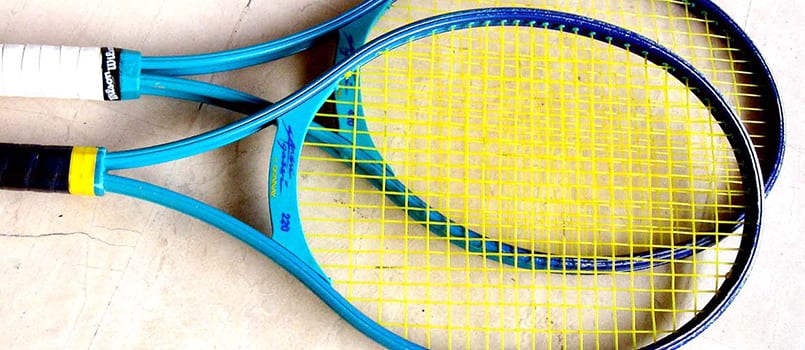My first tennis racquet was one my mom picked up at a discount store in Bellingham when I was nine years old. It had a metal frame and it weighed a tonne. The thing was indestructible. In other words it was perfect for my use as a somewhat careless middle school-aged boy. In fact, forty years later, I still have it and now my kids use it.
Back then, we really didn’t play tennis, it was more of a “try” to hit the tennis ball (or whatever small object you could find) as hard as possible to see how high or far you could send it. To this day, I can hardly believe that those strings have not broken from all the abuse!
As I mentioned in my last post, I was a certified racquet stringer. I learned how to string or re-string badminton, racquetball, squash, and tennis racquets. My favourite was always working on tennis racquets as they were strung at the highest tension and required the most care in lacing the strings.
Tennis racquets are strung, depending on the racquet construction and design, anywhere from about 50 foot pounds up to 120 foot pounds of tension. What is more, there are two basic stringing patterns, a single string that includes the mains (vertical strings) and the crosses (horizontal strings), or a two-piece string pattern. Lower tensions are typically used if the player wants more power when striking the ball, while higher tension strings have the benefit of giving the player more control. My first tennis racquet was strung pretty low, and this resulted in some pretty high speed projectiles on the rare occasions I connected just right.
There are some things about stringing racquets that remind me of best practices when working with people.
First off, there is the obvious one that when a string in a racquet with a higher amount of tension breaks, it is very noticeable and can even lead to permanent damage to the racquet frame as the tension from the remaining intact strings warps the frame. It is also the most difficult break to repair. In a similar way, people who are under a lot of stress can snap and cause damage to those around them and to the community they are a part of.
Another similarity between people and tennis racquet strings is in how they are so interconnected. When one of the strings breaks, it affects the strings on either side of it as well as the strings that it crosses or is laced with. This interconnectedness is a lot like the community we all are a part of; we all feel it when someone within our community is broken or sick or hurting. The difference is that racquet strings can be repaired or replaced while people and relationships are a lot more difficult to “fix.”
Last summer, I watched from a distance as all four of my kids went to play tennis at a nearby set of courts. After about half an hour of chasing errant hits that went over the fence, the older ones had had enough; it was just too much work for the little reward. They were frustrated and the youngest was tired of being sent to retrieve all the balls. Tennis, regardless of how fancy your racquet is, or how well it is strung, is a lot of work. So are relationships.
I kind of miss stringing racquets. There was some skill involved, but mostly it was following rules, and a racquet never argues with you.






WHAT DO YOU THINK?
Wow, that really is a interesting story, Mr. Berger!